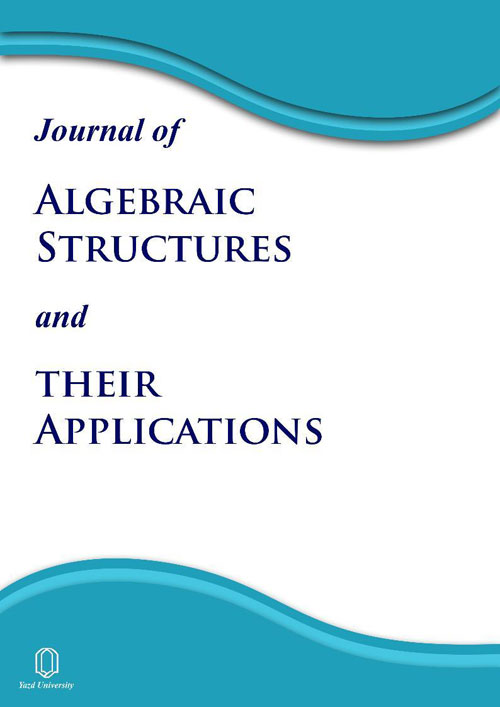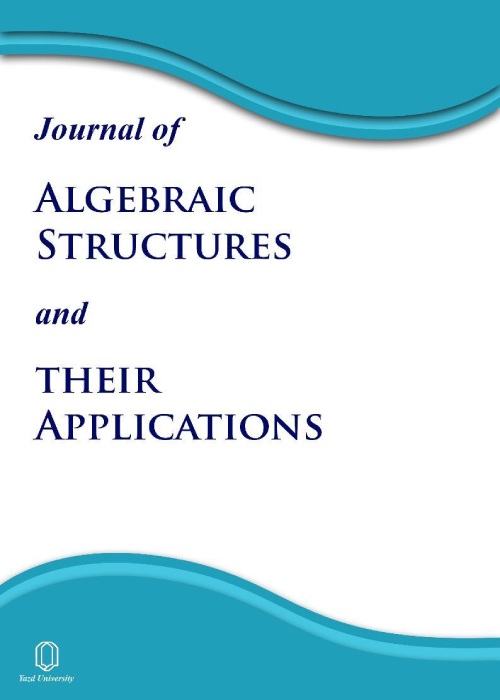فهرست مطالب

Journal of Algebraic Structures and Their Applications
Volume:1 Issue: 2, Summer - Autumn 2014
- تاریخ انتشار: 1394/09/28
- تعداد عناوین: 6
-
-
Pages 77-84The notion of a D-poset was introduced in a connection with quantum mechanical models. In this paper, we introduce the conditional expectation of random variables on the K\^{o}pka's D -Poset and prove the basic properties of conditional expectation on this structure.Keywords: Kopka's D-posets, random variables, conditional expectation
-
Pages 85-103Let G=(V,E) be a simple graph. A set S⊆V is independent set of G, if no two vertices of S are adjacent. The independence number α(G) is the size of a maximum independent set in the graph. In this paper we study and characterize the independent sets of the zero-divisor graph Γ(R) and ideal-based zero-divisor graph ΓI(R) of a commutative ring R .Keywords: Independent set, Independence number, Zero-divisor graph, Ideal
-
Pages 105-115Let G be a non-abelian group and let Z(G) be the center of G. Associate with G there is a graph ΓG as follows: Take G∖Z(G) as vertices of ΓG and joint two distinct vertices x and y whenever yx≠yx. ΓG is called the non-commuting graph of G. In recent years many interesting works have been done in non-commutative graph of groups. Computing the clique number, chromatic number, Szeged index and Wiener index play important role in graph theory. In particular, the clique number of non-commuting graph of some the general linear groups has been determined. \nt Recently, Wiener and Szeged indices have been computed for ΓPSL(2,q), where q≡0(mod 4). In this paper we will compute the Szeged index for ΓPSL(2,q), where q≢0(mod 4) .Keywords: Non-commuting grapg, general Linear group, Szeged index
-
Pages 114-122In this paper we give an elementary argument about the atoms and coatoms of the lattice of all subgroups of a group. It is proved that an abelian group of finite exponent is strongly coatomic.Keywords: Atom, Coatom, Group, Lattice
-
Pages 123-132Let R be a ring with unity. The undirected nilpotent graph of R, denoted by ΓN(R), is a graph with vertex set ~ZN(R)∗={0≠x∈R| xy∈N(R) for some y∈R∗}, and two distinct vertices x and y are adjacent if and only if xy∈N(R), or equivalently, yx∈N(R), where N(R) denoted the nilpotent elements of R. Recently, it has been proved that if R is a left Artinian ring, then \diam(ΓN(R))⩽3. In this paper, using the concept of rank over commutative rings, we investigate basic properties of undirected nilpotent graph of matrix algebras. Moreover, some result on undirected nilpotent graph of matrix algebras over commutative rings are given. For instance, we prove that ΓN(Mn(R)) is not planar for all n⩾2. Furthermore, we show that \diam(ΓN(R))⩽\diam(ΓN(Mn(R))) for an Artinian commutative ring R. Also, we prove that ΓN(Mn(R))≅ΓN(Mn(T(R))), where T(R) be the total quotient ring of a commutative ring RKeywords: Zero-divisor Graph, Nilpotent Graph, Commutative Ring
-
Pages 133-141Let G=(V,E) be a simple graph. Denote by D(G) the diagonal matrix diag(d1,⋯,dn), where di is the degree of vertex i and A(G) the adjacency matrix of G. The signless Laplacian matrix of G is Q(G)=D(G)(G) and the k−th signless Laplacian spectral moment of graph G is defined as Tk(G)=∑ni=1qki, k⩾0, where q1,q2, ⋯, qn are the eigenvalues of the signless Laplacian matrix of G. In this paper we first compute the k−th signless Laplacian spectral moments of a graph for small k and then we order some graphs with respect to the signless Laplacian spectral moments.Keywords: Spectral moments sequence, signless Laplacian, generalized Petersen graph, T?order


